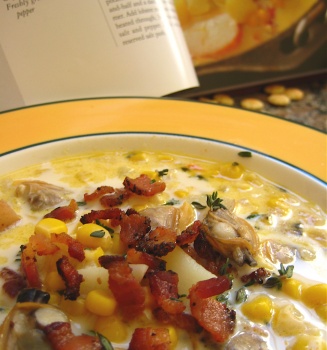The word "chowder" is most likely derived from the chaudière, the three-legged pot or cauldron in which it was cooked, in various forms, all along the Atlantic Coast of France in the centuries prior to European colonization of America.. Others might claim that the word is the bastard child of the Old English jowter, or fishmonger. I vote for chaudière, because I am, at heart, a francophile.
Coincidentally, Atlantic Seaboard-residing, pre-Columbian Native Americans made their own form of chowder which the early English colonists were initially hesitant to latch onto, since they seemed as mistrustful of shellfish as they were of just about everything else. Preferring bivalves to starvation, early settlers added their old standbys of ship biscuit and salt pork to the pot. The rest is, I believe, history.
Corn and Clam Chowder with Bacon
Since just about anything is fair game, in terms of chowder-making, I decided to combine two of my favorites, just to see how things went. A lobster chowder sounded wonderful, but too expensive. Crab, which was local, was at about $30.00 per pound. No thank you. I found some lovely Manila clams, which were not exactly local, but neither were they from Manila. The price was good, so I took them home in a little net bag with the thought of steaming them to death in the near future.
I love corn chowders, too, and anything with bacon it. I thought I'd throw all of these things in my own, legless chaudière and see what happened. The results were excellent. Nothing earth- shattering but, then again, I have no plans to change the world by virtue of my chowder-making. Still, I am pleased.
The various amounts of ingredients are approximate, since I was just letting both the creative and clam juices flow. I neglected to write everything down.

Serves 4
Ingredients:
2 lbs. Manila clams, rinsed clean
1 stalk celery, coarsely chopped
1 medium-sized carrot, likewise chopped
1 yellow onion, peeled and diced.
1 bay leaf
3 stalks of thyme
several black peppercorns
1/4 lb salt pork, diced
3 cloves garlic, peeled and minced
3/4 pound ( five or six) red or other waxy potatoes, cut into 1/2" cubes
2 cups fresh or canned yellow corn kernels, depending upon the season.
1 cup half and half
pinch of pimenton, or cayenne pepper
4 thick slabs of bacon, diced
salt and pepper to taste
Preparation:
1. In a saucepan large enough to accommodate them, lay the clams in with enough water to cover the bottom of the pan about 1 inch. Steam them until they are dead and have released their juice. Remove any unopened clams and give them a proper burial. Remove clam meat from shells. You may either discard the shells at this point or save them for a future crafts project. Set meat aside.
2. Add four cups cold water to the clam liquid, along with carrots, celery, peppercorns, thyme, and bayleaf. To make even clammier, you may add bottled clam juice to this mix. I did not. Cover and simmer on low heat for 45 minutes to one hour. Strain stock through a fine mesh sieve. Return to the same pot and reduce by half.
3. To the chaudière of your choosing, add bacon and fry slowly, rendering as much of the fat as possible. Do so until pieces are crisp. Remove and drain. To the hot bacon fat, add diced salt pork, and sauté over medium-low heat until likewise crisp. Drain and remove.
4. Add onions and garlic to the hot, double pig fat. Cook over low heat until soft, about 20 minutes.
5. Add onion mixture to the clam stock, along with the potatoes, salt pork, and corn. Simmer for about 10 minutes, or until the potatoes are tender. Stir in clams, a pinch of pimenton or cayenne pepper, and half and half. Do not boil, or you will regret it, deeply. Simmer for another 3 to 5 mintues.
6. Ladle into warm bowls and garnish with thyme and crispy bacon which you have not let anyone eat prior to serving. Eat with beer and oyster crackers, unless you have found clam crackers, which I have never in my life heard of. If you have, please send me some.
 I've had chowder on the brain ever since I attended a rally a couple of weeks ago at which I mistook the crowd's chant of "Louder! Louder!" as-- thanks to people blowing horns into my ears-- "Chowder! Chowder!" I was teased about it by a friend of mine (the proud owner of two hearing aids, no less) who leaned over to me afterward to say, "All this heat and talk of marriage is making me crave a hot, milk-based soup."
I've had chowder on the brain ever since I attended a rally a couple of weeks ago at which I mistook the crowd's chant of "Louder! Louder!" as-- thanks to people blowing horns into my ears-- "Chowder! Chowder!" I was teased about it by a friend of mine (the proud owner of two hearing aids, no less) who leaned over to me afterward to say, "All this heat and talk of marriage is making me crave a hot, milk-based soup."